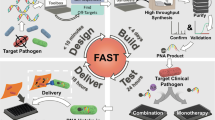Abstract
Antisense PNA-peptide conjugates targeting essential bacterial genes have shown interesting potential for discovery of novel precision antibiotics. In this context, the minimal inhibitory concentration (MIC) assay is used to assess and compare the antimicrobial activity of natural as well as synthetic antimicrobial compounds. Here, we describe the determination of the minimal inhibitory concentration of peptide-PNA conjugates against Escherichia coli. This method can be expanded to include minimal bactericidal concentration (MBC) determination and kill-curve kinetics.
Access this chapter
Tax calculation will be finalised at checkout
Purchases are for personal use only
Similar content being viewed by others
References
Sidjabat H, Nimmo GR, Walsh TR et al (2011) Carbapenem resistance in Klebsiella pneumoniae due to the New Delhi metallo-β-lactamase. Clin Infect Dis 52:481–484. https://doi.org/10.1093/cid/ciq178
Bonomo RA (2011) New Delhi metallo-β-lactamase and multidrug resistance: a global SOS? Clin Infect Dis 52:485–487. https://doi.org/10.1093/cid/ciq179
Tacconelli E, Carrara E, Savoldi A et al (2018) Discovery, research, and development of new antibiotics: the WHO priority list of antibiotic-resistant bacteria and tuberculosis. Lancet Infect Dis 18:318–327. https://doi.org/10.1016/S1473-3099(17)30753-3
Good L, Nielsen PE (1998) Antisense inhibition of gene expression in bacteria by PNA targeted to mRNA. Nat Biotechnol 16:355–358. https://doi.org/10.1038/nbt0498-355
Geller BL, Deere JD, Stein DA et al (2003) Inhibition of gene expression in Escherichia coli by antisense phosphorodiamidate morpholino oligomers. Antimicrob Agents Chemother 47:3233–3239. https://doi.org/10.1128/aac.47.10.3233-3239.2003
Wahlestedt C, Salmi P, Good L et al (2000) Potent and nontoxic antisense oligonucleotides containing locked nucleic acids. Proc Natl Acad Sci U S A 97:5633–5638. https://doi.org/10.1073/pnas.97.10.5633
Harth G, Zamecnik PC, Tang JY et al (2000) Treatment of Mycobacterium tuberculosis with antisense oligonucleotides to glutamine synthetase mRNA inhibits glutamine synthetase activity, formation of the poly-L-glutamate/glutamine cell wall structure, and bacterial replication. Proc Natl Acad Sci U S A 97:418–423. https://doi.org/10.1073/pnas.97.1.418
Hegarty J, Krzeminski J, Sharma A et al (2016) Bolaamphiphile-based nanocomplex delivery of phosphorothioate gapmer antisense oligonucleotides as a treatment for Clostridium difficile. Int J Nanomedicine 11:3607–3619
Dryselius R, Aswasti SK, Rajarao GK et al (2003) The translation start codon region is sensitive to antisense PNA inhibition in Escherichia coli. Oligonucleotides 13:427–433. https://doi.org/10.1089/154545703322860753
Goh S, Boberek JM, Nakashima N et al (2009) Concurrent growth rate and transcript analyses reveal essential gene stringency in Escherichia coli. PLoS One 4:e6061. https://doi.org/10.1371/journal.pone.0006061
Patenge N, Pappesch R, Krawack F et al (2013) Inhibition of growth and gene expression by PNA-peptide conjugates in Streptococcus pyogenes. Mol Ther Nucleic Acids 2:e132. https://doi.org/10.1038/mtna.2013.62
Abushahba MFN, Mohammad H, Thangamani S et al (2016) Impact of different cell penetrating peptides on the efficacy of antisense therapeutics for targeting intracellular pathogens. Sci Rep 6:20832. https://doi.org/10.1038/srep20832
Eriksson M, Nielsen PE, Good L (2002) Cell permeabilization and uptake of antisense peptide-peptide nucleic acid (PNA) into Escherichia coli. J Biol Chem 277:7144–7147. https://doi.org/10.1074/jbc.M106624200
Good L, Awasthi SK, Dryselius R et al (2001) Bactericidal antisense effects of peptide-PNA conjugates. Nat Biotechnol 19:360–364. https://doi.org/10.1038/86753
Vaara M, Porro M (1996) Group of peptides that act synergistically with hydrophobic antibiotics against gram-negative enteric bacteria. Antimicrob Agents Chemother 40:1801–1805
Nekhotiaeva N, Awasthi SK, Nielsen PE, Good L (2004) Inhibition of Staphylococcus aureus gene expression and growth using antisense peptide nucleic acids. Mol Ther 10:652–659. https://doi.org/10.1016/j.ymthe.2004.07.006
Kurupati P, Tan KSW, Kumarasinghe G, Poh CL (2007) Inhibition of gene expression and growth by antisense peptide nucleic acids in a multiresistant beta-lactamase-producing Klebsiella pneumoniae strain. Antimicrob Agents Chemother 51:805–811. https://doi.org/10.1128/AAC.00709-06
Kulyté A, Nekhotiaeva N, Awasthi SK, Good L (2005) Inhibition of Mycobacterium smegmatis gene expression and growth using antisense peptide nucleic acids. J Mol Microbiol Biotechnol 9:101–109. https://doi.org/10.1159/000088840
Martínez-Guitián M, Vázquez-Ucha JC, Álvarez-Fraga L et al (2020) Antisense inhibition of lpxB gene expression in Acinetobacter baumannii by peptide–PNA conjugates and synergy with colistin. J Antimicrob Chemother 75(1):51–59. https://doi.org/10.1093/jac/dkz409
Ghosal A, Nielsen PE (2012) Potent antibacterial antisense peptide-peptide nucleic acid conjugates against Pseudomonas aeruginosa. Nucleic Acids Ther 22:323–334. https://doi.org/10.1089/nat.2012.0370
Goltermann L, Yavari N, Zhang M et al (2019) PNA length restriction of antibacterial activity of peptide-PNA conjugates in Escherichia coli through effects of the inner membrane. Front Microbiol 10:427. https://doi.org/10.3389/fmicb.2019.01032
Bai H, You Y, Yan H et al (2012) Antisense inhibition of gene expression and growth in gram-negative bacteria by cell-penetrating peptide conjugates of peptide nucleic acids targeted to rpoD gene. Biomaterials 33:659–667. https://doi.org/10.1016/j.biomaterials.2011.09.075
Otsuka T, Brauer AL, Kirkham C et al (2017) Antimicrobial activity of antisense peptide-peptide nucleic acid conjugates against non-typeable Haemophilus influenzae in planktonic and biofilm forms. J Antimicrob Chemother 72:137–144. https://doi.org/10.1093/jac/dkw384
Abushahba MF, Mohammad H, Seleem MN (2016) Targeting multidrug-resistant Staphylococci with an anti-rpoA peptide nucleic acid conjugated to the HIV-1 TAT cell penetrating peptide. Mol Ther Nucleic Acids 5:e339. https://doi.org/10.1038/mtna.2016.53
Hansen AM, Bonke G, Larsen CJ et al (2016) Antibacterial peptide nucleic acid-antimicrobial peptide (PNA-AMP) conjugates: antisense targeting of fatty acid biosynthesis. Bioconjug Chem 27:863–867. https://doi.org/10.1021/acs.bioconjchem.6b00013
Równicki M, Wojciechowska M, Wierzba AJ et al (2017) Vitamin B12 as a carrier of peptide nucleic acid (PNA) into bacterial cells. Sci Rep 7:7644. https://doi.org/10.1038/s41598-017-08032-8
Cockerill FR,Wikler MA, Alder J et al Methods for dilution antimicrobial susceptibility tests for bacteria that grow aerobically; approved standard—ninth edition. Accessed 8 Jan 2019
Author information
Authors and Affiliations
Corresponding author
Editor information
Editors and Affiliations
Rights and permissions
Copyright information
© 2020 Springer Science+Business Media, LLC, part of Springer Nature
About this protocol
Cite this protocol
Goltermann, L., Nielsen, P.E. (2020). PNA Antisense Targeting in Bacteria: Determination of Antibacterial Activity (MIC) of PNA-Peptide Conjugates. In: Nielsen, P. (eds) Peptide Nucleic Acids. Methods in Molecular Biology, vol 2105. Humana, New York, NY. https://doi.org/10.1007/978-1-0716-0243-0_14
Download citation
DOI: https://doi.org/10.1007/978-1-0716-0243-0_14
Published:
Publisher Name: Humana, New York, NY
Print ISBN: 978-1-0716-0242-3
Online ISBN: 978-1-0716-0243-0
eBook Packages: Springer Protocols




